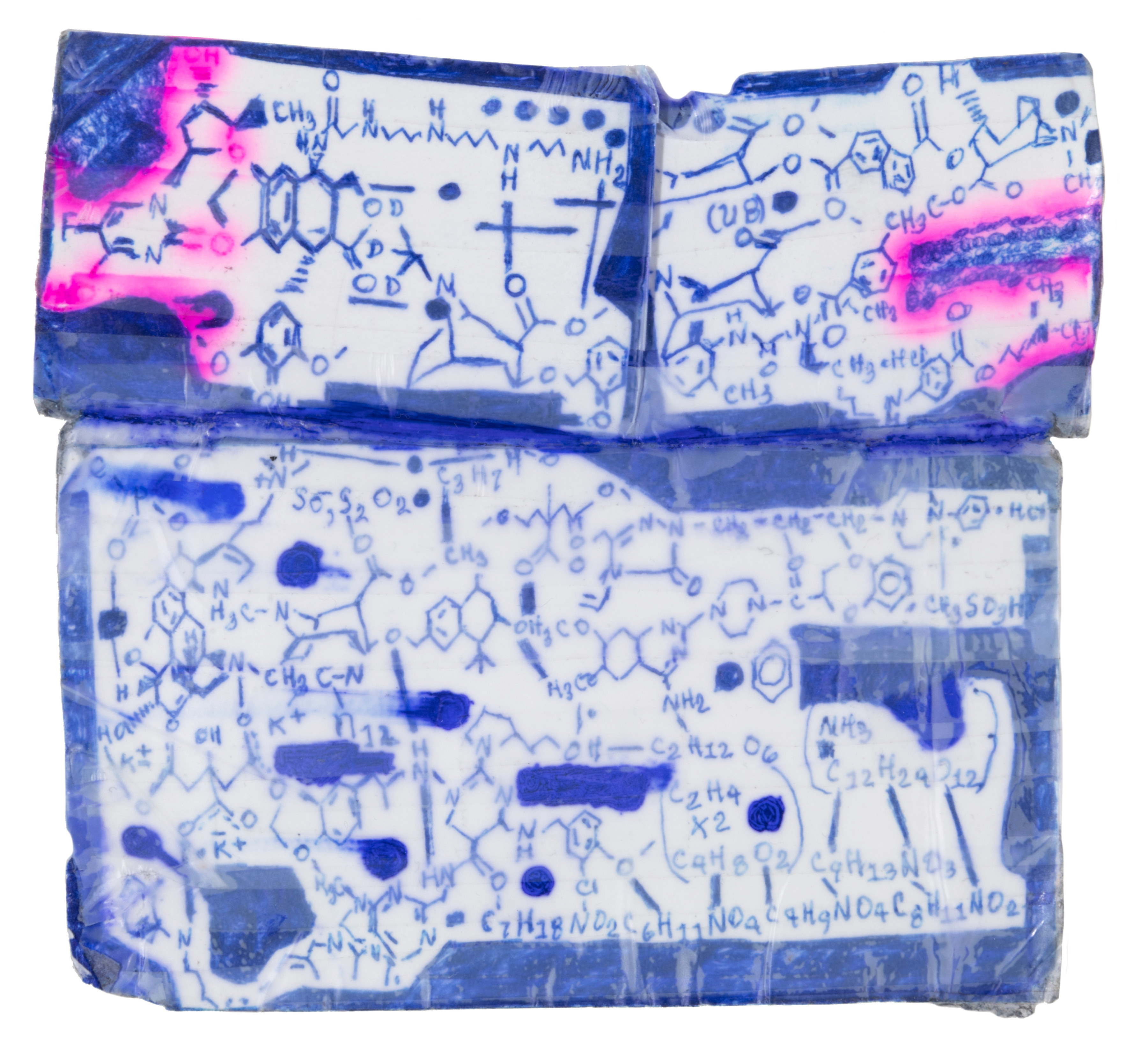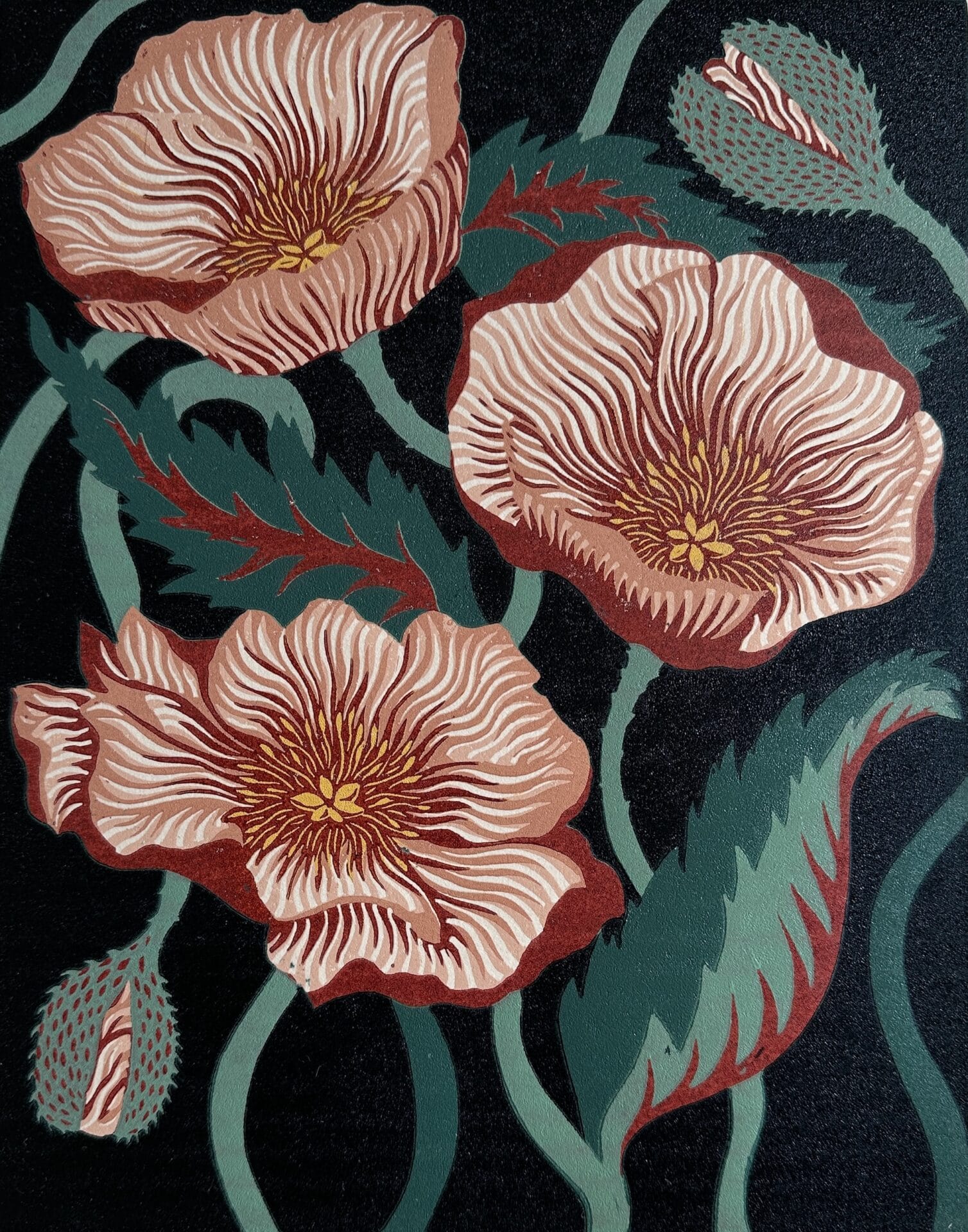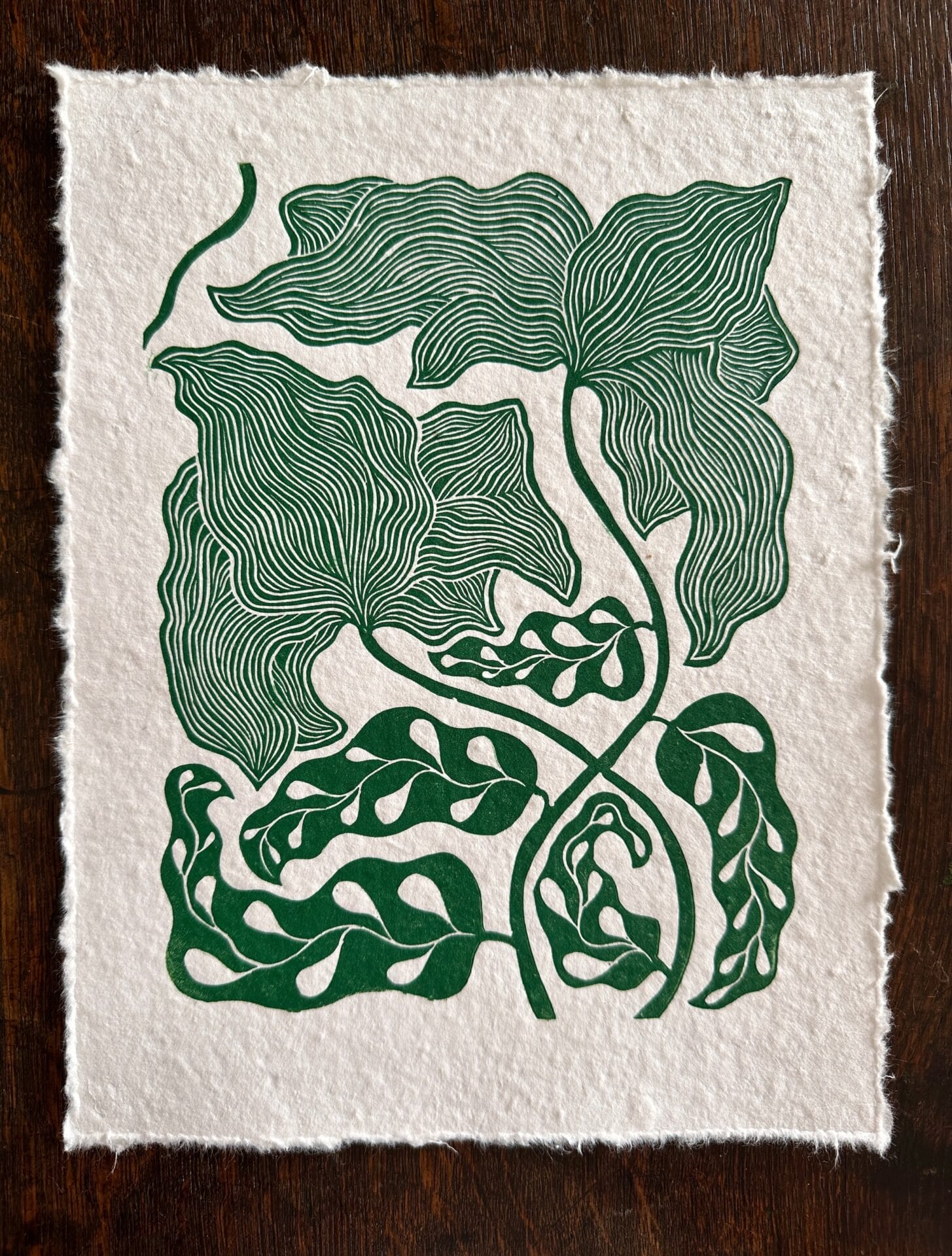Born 1954, South Carolina. Melvin “Milky” Way is an Outsider Artist whose work occupies the uncharted border between art and science. Born in South Carolina in 1954, Way came to New York City in the 1970s to attend a technical school, earning a certificate to operate a power press. He played bass in local bands, and recorded a solo album with Encounter Records, which folded before the album could be released. Soon after, Way was diagnosed with schizophrenia, and following a string of unsuccessful relationships, became homeless. By 1989 Way was residing in the shelter run by Hospital Audiences International, a nonprofit organization offering art workshops to people with disabilities. Lower East Side artist Andrew Castrucci, a volunteer workshop leader at the time, encouraged Way to make art, and acted as his advocate during subsequent years. Way soon began to produce small, exquisite ballpoint-pen and ink drawings on found paper. Despite the very straightforward of his chosen genre, Way’s drawings are strikingly complex. Rich hybrids of scrawled text, mathematical equations, astronomical shorthand, chemical formulae, and alchemical punning, each work is marked by the artist’s signature, thrillingly dense sensibility. Way engages both the eye and the mind, drawing viewers into exquisite mysteries that may never be solved.- Jenifer P. Borum
Monthly Archives: February 2024
Monday Musings — 12FEB24
Let’s talk libraries. What are libraries beside book warehouses. They are community hubs that have programs for kids and adults alike, They are used for research, information and quiet studying.
Gen Z seems to love public libraries. A November report from the American Library Association (ALA) drawing from ethnographic research and a 2022 survey found that gen Z and millennials are using public libraries, both in person and digitally, at higher rates than older generations.
More than half of the survey’s 2,075 respondents had visited a physical library within the past 12 months. Not all of them were bookworms: according to the report, 43% of gen Z and millennials don’t identify as readers – but about half of those non-readers still visited their local library in the past year. Black gen Zers and millennials visit libraries at particularly high rates.
To glimpse what he means, one need only dip into Frederick Wiseman’s epic and inspirational three-hour-and-seventeen-minute documentary Ex Libris, a picaresque tour of the grandest people’s palace of all: the New York Public Library system, a collection of ninety-two branches with seventeen million annual patrons (and millions more online). Wiseman trains his lens on the quotidian (people lining up to get into the main branch or poring over books), the obscure (a voice actor recording a book for the blind), and the singular (Khalil Muhammad discussing the Schomburg Center for Research in Black Culture), and without saying so explicitly (the film is unnarrated), he shows the NYPL to be an exemplar of what a library is and what it can do. Here we see librarians helping students with math homework, hosting job fairs, running literacy and citizenship classes, teaching braille, and sponsoring lectures. We see people using computers, Wi-Fi hotspots, and, of course, books. They are white, black, brown, Asian, young, homeless, not-so-young, deaf, hearing, blind; they are everyone, which is the point. If you want to understand why the Trump administration eliminated federal funding for libraries in its 2018, 2019, and 2020 proposed budgets, it’s on display in this film: public libraries dismantle the walls between us.This is by design. A statement issued by the Public Library Association in 1982 called “The Public Library: Democracy’s Resource” said:The public library is unique among our American institutions. Only the public library provides an open and nonjudgmental environment in which individuals and their interests are brought together with the universe of ideas and information…. The uses made of the ideas and information are as varied as the individuals who seek them. Public libraries freely offer access to their collections and services to all members of the community without regard to race, citizenship, age, education level, economic status, or any other qualification or condition.Free access to ideas and information, a prerequisite to the existence of a responsible citizenship, is as fundamental to America as are the principles of freedom, equality and individual rights.
And they have become a place where homeless people can find shelter during the day, and help via in house social workers.
On a bitterly cold Friday this February, the final day of the 2023 event, vendors in the exposition hall upstairs were busy hawking everything from book-moving services to exotic animal visits. Former Toronto mayor David Miller sat alone at the University of Toronto Press booth, surrounded by copies of his latest hardcover, while a buzzy line formed down the aisle for signed copies of a picture book about a giant beet. Downstairs, in the corporately neutral confines of meeting room 202D, a full house had gathered to talk about one of the burning issues at the heart of the modern public library.
Rahma Hashi, a social worker with a bright smile and a beige head scarf, began the session. Over the past decade or so, in response to the waves of vulnerable people arriving at their doors, many North American libraries have begun hiring in-house social workers. Hashi was one of Toronto Public Library’s first. Part of her role, she explained, was to make partnerships with shelters, with the idea that the library should always be a welcoming place for everyone but the real work of providing service to people who are homeless should be handled by the professionals.
They are the last bastion against the rising tide of book banners. People (on both sides of the aisle) who think that they have the right to ban books for having something in them that they disagree with.
Books predominantly get removed from school libraries, with only a small percentage of book bans impacting classrooms specifically. Most books are removed pending investigation, meaning that a book is removed whenever there’s a challenge for review.
Many of these books are removed from student access before due process of any kind is carried out, according to PEN America. In some cases, books can also be removed without challenges for review. These books often end up being unavailable for weeks or months.
And of course capitalism is making it all got to shit anyways.
In the long term … I don’t know. The biggest obstacle I see is neither patrons nor libraries, but publishers. Libraries ultimately have service goals, and some libraries already have a secondary platform (even if OverDrive is the dominant one by far). But corporate publishers have only profit goals, and I imagine OverDrive’s lure of a giant stream of marketing data would continue to be compelling, even if their monopoly was successfully broken.
Alternative platforms already exist: one promising place to start might be the Palace Project and the associated Palace Marketplace, which right now mostly seems to let libraries buy ebooks and audiobooks from indie authors, and access out-of-copyright classics. The company behind it, Lyrasis, is a 501(c)(3) nonprofit; that doesn’t mean it’s immune to mismanagement, but it’s a better legal framework than a for-profit B corp. And its board is teeming with actual career librarians, instead of one token librarian and a handful of investors and executives, like OverDrive. The Palace app is designed to combine content from multiple vendors, including OverDrive, which could help with transition. But the Palace Project so far has relationships with less than 5% of US libraries.7
I don’t have a neat solution to the fact that OverDrive has a functional monopoly in the space, or that it’s now owned by vampires. All I know to do is point at the dead canary and yell as loud as I can.
I asked my reporter friend how I might go about getting a real journalist to write about it, and she regretfully advised me that she didn’t think it was a big enough story yet to get any professional interest. Once public libraries have actually been devastated by private equity, it’ll be a story.
It will also be too late.
I’ll leave you with this:
Please support you local library. And actually use it once in a while.
Grace Gillespie’s Vibrant Linocut Prints of Flowers and Foliage Tap Into Her Artistic Roots — Colossal
Grace Gillespie grew up in an artistic household, but she resisted pursuing visual art at first, especially printmaking, because it was something both of her parents excelled at. “I guess I wanted my own ‘thing,’” she tells Colossal, which for most of her twenties was music. Then, during the pandemic, she found herself furloughed, disillusioned with the music industry, and back at her parents’ home in Devon, England.During her six-month stay, Gillespie had access to a large etching press belonging to her mother, artist Sarah Gillespie. “I decided to try my hand at linocut and was immediately very addicted!” the artist says. “I was also just incredibly lucky that (my parents) had a lot of old lino and tools lying around—a bit ancient and rusty, but they did the trick.”
Monday Musings — 5FEB24
How about a book review?
Just finished this book, which has 2 long form interviews with Moebius, and a couple of shorter ones, and some other biographical stuff, and more.
This is definitely a book for the hardcore Moebius/Gir fan, and most people wouldn’t find it quite as interesting. It’s mor than just about his comics, it is in fact a biography written through interviews. It deals with his childhood, time in Mexico, his many Mentors/father figures, his drug experimentation, his philosophy, and also how he came to work on his various comics.
I found some of it tedious, but the parts I found so, might interest other people more. I think it came mostly from the interviewer trying to wring out all the juice from certain times in a couple of “cults”.
All in all it was a fascinating look at the life of one of the greatest comics artist who ever lived.
/https://tf-cmsv2-smithsonianmag-media.s3.amazonaws.com/filer/Janice-Lawry-diary-631.jpg)
Artist Janice Lowry regarded the notebooks as “126 chapters of a memoir.” Her life’s journey, chronicled in her diaries, ended Sept. 20, 2009, when she succumbed to liver cancer. Archives of American ArtWhen Janice Lowry turned 11, inspired by reading The Diary of Anne Frank, she began keeping a journal. Not unusual for a young girl. What’s unusual is that throughout her life, Lowry—who died of liver cancer this past September at age 63—kept up her diaries.
From childhood on, Lowry filled small notebooks with daily musings and drawings. Then, in the mid-1970s, she moved to a larger format, 7 1/2- by 9 1/2-inch notebooks. For almost 40 years, Lowry—an artist best known for her intricate, three-foot-tall assemblages—filled the roomier notebooks with jottings and sketches. The pages contain everything from original drawings, collages and rubber-stamp images to observations about herself and the world, including the commonplace “to-do” lists many of us make: “pay bills/make plane res/get asthma med/Judi birthday gift.”
RIP Wayne Kramer
Wayne Kramer, the guitarist who co-created MC5 – of the rawest, most influential and politically engaged bands in US history – has died aged 75. His Instagram page announced the news: “Wayne S Kramer. Peace be with you. April 30 1948 – February 2 2024.”
That’s it for this Monday. The week is yours, use it wisely.



